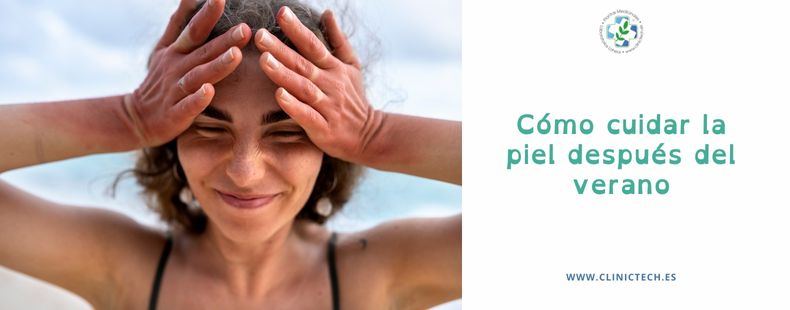
Cómo cuidar la piel después del verano
02 Sep 2024El verano es una época maravillosa, llena de días soleados, playa, piscina y momentos inolvidables. Sin embargo, la exposición al sol, el cloro de las piscinas y la sal del mar pueden causar estragos en nuestra piel, dejándola reseca, manchada y deshidratada.
Si es tu caso, ¡no te preocupes! Te mostramos de forma rápida y sencilla cómo recuperar tu piel después del verano. ¡Toma nota!.
¿Qué le pasa a la piel en verano?
Aunque la radiación solar es esencial para nuestro cuerpo, una exposición prolongada y sin control puede tener efectos negativos en nuestra piel. La radiación ultravioleta puede causar manchas, pérdida de colágeno y elastina, lo que resulta en líneas de expresión y arrugas debido al fotoenvejecimiento.
A largo plazo, puede provocar afecciones graves como la queratosis actínica o el cáncer de piel. Por eso es crucial proteger la piel diariamente antes, durante y después de la exposición al sol.
La combinación de cloro de piscina y agua de mar puede llevar a la deshidratación y falta de brillo en la piel. Pero no te preocupes, aquí te presentamos cinco consejos para devolverle a tu piel su luminosidad perdida.
Cómo cuidar la piel después del verano
La exposición prolongada al sol puede causar daños, por ello a continuación te daremos algunas claves para recuperar la piel después del sol y mantenerla saludable. ¡Vamos allá!.
1. Evalúa el estado de tu piel
Lo primero es lo primero. Olvídate de esa rutina que te sentaba tan bien en primavera o de esas cremas que te esperan como agua de mayo en el armario. Tu piel ha pasado tres meses expuesta al sol y puede que las necesidades que tenía antes del verano no sean las mismas que tiene ahora.
Es por eso que el primer paso antes de decidir qué rutina utilizar es evaluar el estado de tu piel. ¿Manchas? ¿Piel apagada? ¿Sequedad? Una vez tengas claro el estado de tu piel, sabrás qué rutina funcionará mejor.
2. Apuesta por una buena exfoliación e hidratación corporal
Nada como una buena exfoliación. Te ayudará a renovar la superficie y a eliminar las células muertas de la piel. ¿Nuestras recomendaciones? Hazlo de noche para que así tu capa hidrolipídica protectora tenga tiempo de regenerarse y no utilices el mismo exfoliante para cara y cuerpo, ya que cada zona tiene necesidades distintas.
Para el rostro, lo mejor es utilizar fórmulas que contengan ácido glicólico, ya que su gran poder exfoliante y reparador ayuda a renovar, iluminar y regenerar la piel de manera muy eficaz. Cada piel puede tolerar un límite de concentración de ácido glicólico, así que nuestra recomendación es comenzar por la concentración más baja e ir aumentando poco a poco si la tolerancia es óptima.
3. Retoma tus hábitos de vida saludables
Qué bien sienta desconectar de vez en cuando, ¿verdad? Cuando las vacaciones lleguen a su fin, recuerda retomar tus hábitos poco a poco.
Bebe mucha agua, vuelve al gym, da largos paseos, descansa, come bien y lleva un estilo de vida saludable para que tu cuerpo vuelva a estar a pleno rendimiento ¡por dentro y por fuera!.
4. Dale a tu rostro un extra de hidratación
El verano es sinónimo de sequedad en la piel, así que opta por incorporar a tu rutina de belleza productos que te ayuden a recuperar el buen estado de tu piel. ¿Quieres saber un secreto? Las fórmulas con ácido hialurónico, además de hidratar en profundidad, te ayudarán a combatir los signos del envejecimiento. ¡Notarás la diferencia!.
5. Fotoprotégete a diario
Aunque el verano termine, los rayos UV continúan a pleno rendimiento, por eso es fundamental aplicarse un fotoprotector de manera rutinaria, especialmente en aquellas partes del cuerpo que vayas a exponer. Para el rostro es siempre una opción segura.
Recuperar el cutis después del exceso de sol,y arena requiere de constancia. Por ello también es clave realizar una buena limpieza diaria a fondo con las toallitas de bambú.
6. No olvides revisar lunares y pecas
Y por último, pero no por ello menos importante,recuerda examinar la piel del cuerpo de forma regular (muy especialmente después del verano), ya que la exposición solar puede acelerar la aparición de lunares y pecas. Si identificas cualquier lunar o mancha anormal, no dudes en acudir al dermatólogo.
En Clinictech somos especialistas en ayudarte a cuidar tu piel después de un verano muy intenso. No olvides que es el momento del año en el que la piel se vuelve más sensible y frágil.




 Músculo
Músculo
 Óseo
Óseo
 Grasa
Grasa
 Caloría
Caloría
 Índice Masa Corporal
Índice Masa Corporal
 Agua
Agua
 Cálculo
Cálculo


